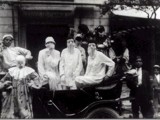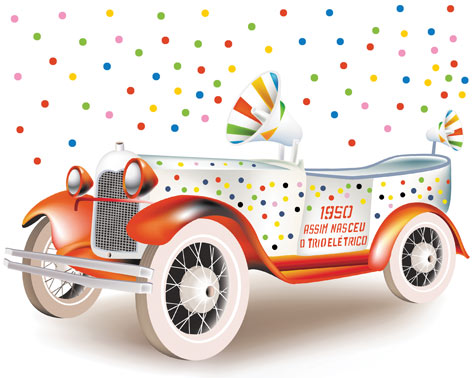Este post também está disponível em:
Português
English

The origin of Carnival is a controversial subject. Some historians associate the beginning of the carnival festivities with the cults performed by the ancients to praise good agricultural harvests, ten thousand years before Christ.
Others say that it began later, in Egypt, in honour of the goddess Isis and the bull Apis, with dances, parties and masked people. Some attribute the beginning of Carnival to the Greeks, who celebrated the return of spring and the cult of the God Dionysus. And others speak of Ancient Rome with its bacchanals, saturnals and lupercals in honour of the gods Bacchus, Saturn and Pan.
Hiram Araújo, in his book Carnival, reports that the origin of carnival festivities cannot be precisely established, but that it must be related to agrarian cults, Egyptian festivals and, later, the cult of Dionysus, a ritual that took place in Greece between 605 and 527 BC.
One thing, however, is common to all: Carnival has its history, like all great festivals, linked to astronomical or natural phenomena. Carnival is characterised by parties, public entertainment, masked balls and folkloric manifestations.

Origem e História do Carnaval no Brasil
The word carnival also has several versions and there is no unanimity among scholars. Some argue that the term carnival derives from carne vale (goodbye meat!) or from carne levamen (suppression of meat).
This interpretation of the etymological origin of the word takes us back to the beginning of Lent, which was originally not only a period of spiritual reflection but also a time of deprivation of certain foods, including meat.
Another interpretation of the word’s etymology is that it derives from currus navalis, an expression that predates Christianity and means naval chariot. This interpretation is based on the amusements of early spring, with maritime parades or floats in the shape of boats, both in Greece and Rome.
In Brazil, Carnival was called Entrudo due to the influence of the Portuguese who brought carnival games and festivities with them in 1723. Many attribute the beginning of our carnival to the celebration held by the people to commemorate the arrival of the Royal Family. People went out celebrating in the streets with music, wearing masks and costumes.
The following are some of the most important events in the history of Brazilian carnival:
The floats arrived in 1786, on the occasion of Dom João’s wedding to Carlota Joaquina.
Around 1846, there was an event that revolutionised Rio’s carnival: the appearance of Zé Pereira (a drummer). Zé Pereira’s successors were the cuíca, the tambourine, the reco-reco, the pandeiro and the frigideira, instruments that accompanied the ‘dirty’ blocos and which today animate our samba schools.
Until the appearance of the first samba schools, the carnival parades of the so-called “societies” (clubs or organisations that, with their allegories and satires of the government) predominated in Rio’s carnival. The first club to parade, in 1855, was called Congresso das Sumidades Carnavalescas.
From the 1870s, the crossing of rhythmic influences such as lundu, polka, maxixe and tango generated a type of music with samba characteristics. At the end of the 19th century, the dance parties of black slaves were called samba. To the rhythm of the samba, the whole country began to dance in clubs and the first cordões de folia emerged. Still in this century, one of the most notable events of our carnival was the Masked Ball at the Hotel Itália (Largo do Rocio, RJ) in 1840, organised on the initiative of the hotel’s owners, Italians excited by the success of the great masked balls in Europe.
In 1873, the first rancho parade took place, the Dois de Ouros, led by Hilário Jovino Ferreira from Bahia.
In 1899, the appearance of music made for carnival, Chiquinha Gonzaga’s Abre-Alas, marked the popularisation of Brazilian carnival and gave rise to the compositions called marchinhas carnavalescas.
By 1902, there were more than 200 carnival groups. We also find at the beginning of the 20th century: masquerades, perfume throwing, confetti battles and children’s dances that gave rise to the famous matinees.
The emergence of samba was a powerful democratising factor in Rio de Janeiro. At first, the elite reacted to the “African manifestation”. The first recorded samba, recognised by most popular music researchers, was Pelo Telefone, by Ernesto dos Santos (Donga) and Mauro de Almeida. The first recording of the inaugural samba was made for Casa Edison in Rio de Janeiro by the singer Bahiano, accompanied by the Casa Edison Band, and achieved public notoriety during the carnival of 1917.
In 1928, the first samba school, Deixa Falar, was created, followed soon after by Mangueira. And in 1929, the parades began, which were held in Praça Onze. The first competition between samba schools took place in 1932 and was organised by journalist Mário Filho.
In 1942, the parades moved to Avenida Presidente Vargas. By 1963, the schools had become the centre of attention of the Brazilian carnival and, in 1974, the Rio de Janeiro parade moved to Avenida Rio Branco until 1984, when the Sambódromo was inaugurated.
Nowadays, Carnival is celebrated on the Saturday, Sunday, Monday and Tuesday before the forty days from Ash Wednesday to Easter Sunday. In Bahia it is also celebrated on the Thursday of the third week of Lent, changing its name to Micareta. This festival gave rise to several others in the north-eastern states, the so-called “off-season carnival” such as Fortal in Fortaleza, Carnatal in Natal, Micaroa in João Pessoa, Recifolia in Recife, Micaru in Caruaru and others.
Today carnival has become a major tourist attraction. We can say that Carnival is today Brazil’s biggest folk festival.
Related Articles
- History and Chronology of the Carnival of Salvador de Bahia
- King Momo, Pierrô, Harlequin and Colombina – Carnival Characters
Bahia.ws is the largest tourism and travel guide for Bahia and Salvador.



















